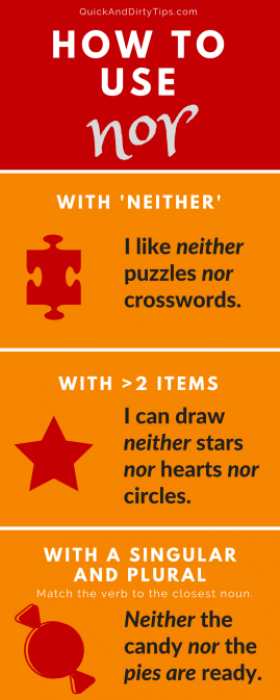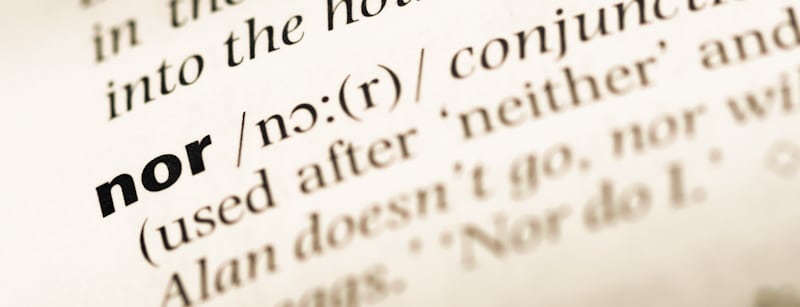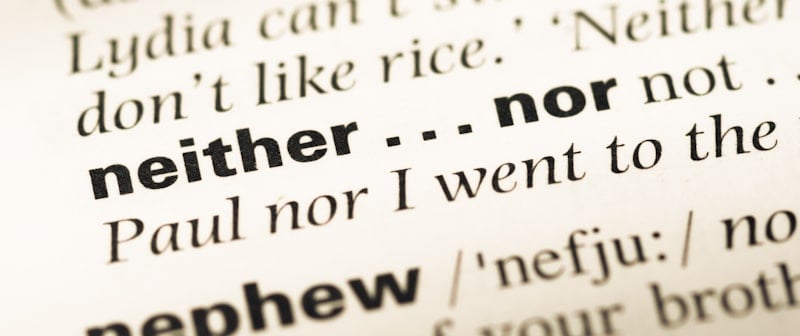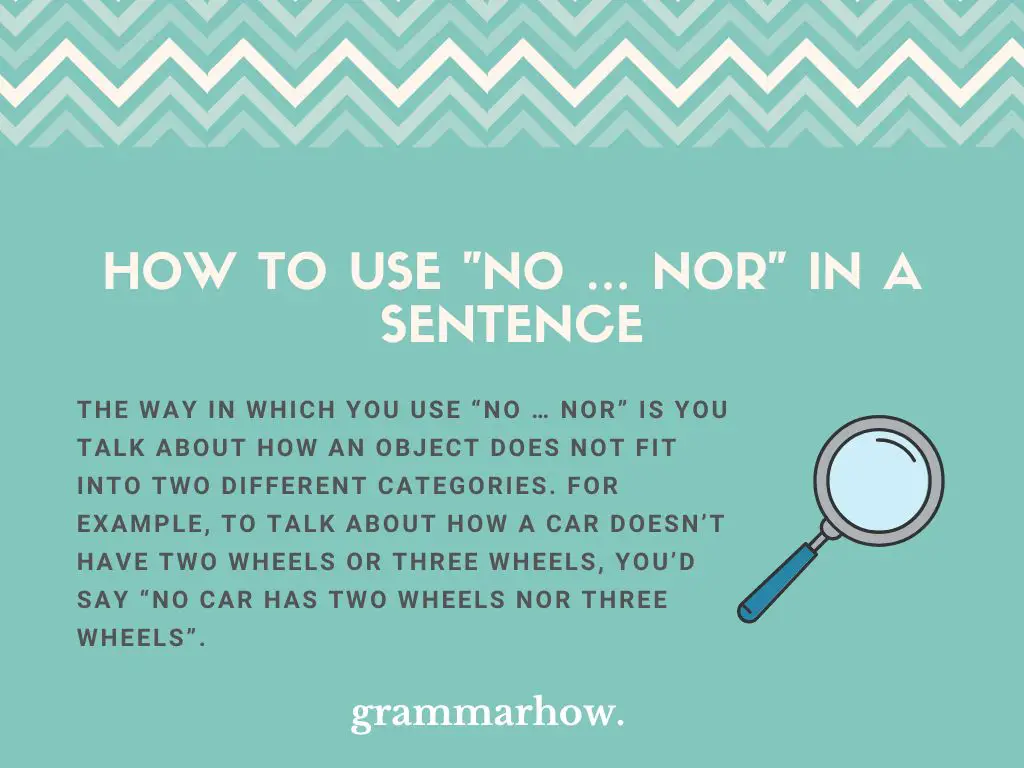Conjunctions are words used to bring together two distinct clauses or thoughts. However, using these words to bridge two statements could be at times confusing – particularly if the connecting word is not as common or straightforward as «but» or «and». In other words, many writers stumble when using the word «nor» to link sentences.
To correctly use «nor» in a sentence, make sure the conjunction introduces a negative element or clause. Though «nor» can be used as a standalone word, it’s mostly paired with «neither», an indefinite pronoun. Most importantly, do not use «either» instead of «neither» as a companion word for «nor».
Keep reading to learn everything there is to know about using «nor» in a sentence (with and without «neither»), some example sentences with «nor» and with both «neither» and «nor» in them, and lots more.
Nor – Definition
The conjunction «nor» is a negative particle or connective that introduces the second negative clause or element in a sentence – typically following «neither» used in the first clause. This relationship between «neither» and «nor» is the opposite of the word pairing of «either» and «or», with the latter pair having positive connotations. Needless to say, «either» and «nor», or «neither» and «or» cannot be paired together.
As aforementioned, «nor» is used in a sentence post a negative statement, to introduce one more negative element that adds to the first statement.
Beginning a Sentence with «Nor»
It’s perfectly fine to begin a sentence with «nor». Those sentences are usually conversational in nature or immediately follow another sentence.
For example, Tom says «I have never used an iPhone before.» To which, Mary could say, «Nor have I.»
Starting a sentence with «nor» may sound a bit formal. If you’d like to make the conversation less formal, you may replace «nor» with «neither». In other words, the second sentence in the above example could be, «Neither have I.»
The first sentence of a new paragraph usually cannot begin with «nor» since the word is a conjunction. If it’s used at the beginning of a sentence, the reader would want to know the context in which the sentence lies. For instance, the sentence «Nor have I» sounds incomplete and meaningless if it has no prior sentence to base itself on.
Here are a couple more sentences to explain the point:
«I have described the situation to you over and over again, but you just don’t seem to understand. Nor are you willing to try to make yourself understand.»
If you read just the second sentence starting with «nor» above, it would mean almost nothing.
Using «Neither» and «Nor»
In a sentence, «nor» is usually paired with «neither». «Neither» is used before «nor» to set up the premise so that «nor» could introduce the next alternative or a set of alternatives. This pairing of the two words is called «correlative pairing», which states the information a particular term introduces is related or connected to the information introduced by the other term. The two words could be incorporated when discussing events or when listing nouns.
However, «nor» is not always dependent on or needs «neither» in a sentence. It could at times feature in sentences without «neither» in the initial clause. In such cases, the conjunction is typically a part of the first clause.
Also, «nor» and «neither» are interchangeable. Take a look at the following sentences:
- He cannot fix my phone and neither/nor can I.
- The cops are unable to take questions at this point in time, nor/neither can they make public the name of the suspect.
- My family didn’t believe in me, nor/neither did my close friends.
Though a sentence can have the conjunction «nor» by itself, it isn’t the norm. The sentence with just «nor» could, in fact, read a bit unnatural and stiff at times. And since the usage of «nor» without «neither» is not common, it may lead to some readers believing you framed the sentence wrong.
Another point worth mentioning is both «neither» and «nor» work parallelly. This means the clauses or phrases they introduce individually should be of the same type. In other words, the phrase that follows the two words should be a noun or a verb. «Neither» cannot be introducing a noun, and «nor» introducing a verb in the same sentence. For example,
- «She saw neither Jim nor Andre during the excursion.» This sentence is correct as both «neither» and «nor» are introducing the proper nouns «Jim» and «Andre» respectively.
- «She neither saw Jim nor spoke to Andre during the excursion.» This sentence is also correct as the two correlative words introduce a verb.
- «She neither saw Jim nor Andre during our trip.» This sentence is not correct as the word «neither» is followed by a verb, whereas a noun follows «nor».
As mentioned above, «neither» and «nor» introduce clauses that have negative undercurrents, and «either» and «or» have positive connotations. This means breaking the respective pairs and interchanging the words is incorrect. In other words, the following sentences are wrong:
- Todd neither knows the game’s rules or tries to know.
- I will either head to the bookstore nor buy groceries.
Also, if the sentence has its tenses mixed, consider the second noun – which is usually the noun after «nor». The verb should be determined based on the tense of the second noun or «nor».
Here are a couple of sentences for a better understanding of the rule:
- Neither they nor she are keen. (Incorrect)
- Neither they nor she is keen. (Correct)
Using «Nor» in the Same Sentence Twice
Like mentioned before, «nor» is used in a sentence to introduce a secondary clause or element. When it’s introducing more than one element, however, the word could be used more than once in the same sentence.
Here is a sentence with «nor» mentioned once:
- I like neither goat milk nor camel milk.
The two elements in the sentence are «goat milk» and «camel milk». If the same sentence had more than two elements, it would read like this:
- I like neither goat milk nor camel milk nor cow milk. I like only buffalo milk.
Here are a couple more sentences with a couple of mentions of «nor»:
- He can neither write nor read, nor is he capable of comprehending such concepts.
- They will not wait for me, nor for you, nor for anybody.
Also, the conjunction «nor» could feature more than twice in the same sentence. Here is an example sentence:
- Neither rain, nor snow, nor night gloom, nor heat can prevent these courier companies from completing their appointed rounds.
Using «Or» in Place of «Nor»
The conjunction «nor» is used to denote a continuing negative state. The two negative items emphasized using the words «neither» and «nor» are part of the same speech. However, there are instances when you can use «or» instead of «nor».
Typically, a sentence that uses «or» doesn’t have «neither» in it. The conjunction «neither» is invariably replaced with «not». Here are a few sentences illustrating the point:
- She is not keen on studying science or math.
This sentence cannot be framed as, «She is neither keen on studying science or math.»
Similarly, «He didn’t speak clearly or slowly» is grammatically correct. On the other hand, «He didn’t speak clearly nor slowly» is not right.
Example Sentences with the Word «Nor»
The following are sentences that incorporate the word «nor»:
- The virus cannot survive in people with strong immunity, nor in nature.
- I do not work for anyone other than Jim, nor do I bid on behalf of anybody else.
- I smiled from the heart, without a curfew nor bounds.
- She wants to leave the town when she is 21, nor does she want to move to the neighboring city.
- The fans do not want to see her go – nor do I.
- Cooking does not mean a sacrifice of flavors and taste. Nor do all fast-food items are junk.
- I am almost never up at 5 in the morning, nor would I like waking up at 6 am.
- The report was finished on time, nor are there any mistakes in it.
- He did not hear the birds nor the clock.
- I won’t go. No omens nor auspicious signs can convince me.
- She’s extremely fun to be around, with no attitude nor eclectic behavior.
Here are sentences that use both «neither» and «nor»:
- The trip was neither great nor bad – it just was.
- Having said that, neither Tim nor I smoke.
- Neither that behavior nor that statement is helping reduce the tension.
- Neither Mr. Wood nor Mr. Terrence showed up for the meeting held yesterday.
- I can neither offer you advice nor an opinion.
- I neither like pizza nor fancy the cheese.
- She drinks neither beer nor wine.
- Neither Mary nor Tom can speak Spanish.
- Neither dogs nor cats are permitted into the restaurant.
- Tony was a complete wreck, and I am quite sure neither Jacob nor I was any better.
- Neither my dad nor my mom went to college.
Conclusion
The conjunction «nor» offers a lot more options to link two or more sentences or create lists. However, in the process of doing so, quite a few adept writers could end up making errors atypical of them. It’s, therefore, imperative to pay close attention to sentence structure and formation when using «nor» and other conjunctions.
If you are a newbie writer or a non-native speaker working on their English, particularly writing in the language, above are some major pointers for your perusal.
Shawn Manaher is the founder and CEO of The Content Authority. He’s one part content manager, one part writing ninja organizer, and two parts leader of top content creators. You don’t even want to know what he calls pancakes.
Knowing when to use nor in your writing might not seem too important, but it’s a subtlety worth studying.
Writing in the English language can be a bit of a challenge even if English is your first language. There are so many grammatical rules that fluctuate depending on the context of a sentence, such as “I” before “e” except after “c.”
Then we have those difficult phrases. One example is “I couldn’t care less,” which has been misspoken so frequently it now seems acceptable to say “I could care less” (although listeners understand it to mean the speaker could not care less).
People often say “daughter-in-laws” when the correct form is “daughters-in-law.”
And then there is figuring out when to use “a” and “an” when the following word starts with a silent consonant.
These are only a few grammar rules that are easy to confuse. As writers, it’s important to understand grammar rules, just as it’s important to understand writing rules, so you know when, how, and if to break them.
We learned many of them in school, but if you’ve been out of school for any length of time, or even if you’re still in school and feel inundated with grammar rules, brief refreshers can go a long way in helping your writing shine.
Before we begin, please note: Great writing doesn’t always follow grammar rules.
- To feel real and ensure your writing is easy to read, dialogue should not follow all grammar rules, unless a specific character would speak in perfect grammar
- In fiction, fragments are acceptable, as long as they add to the story and do not distract (for instance, writers often use fragments to make a point or in description)
- In nonfiction, voice is especially important. If your voice feels more natural and is less grammatical, that’s acceptable.
- In creative writing, use grammar rules to add to your story, not to distract from it.
To talk about the word nor, we should first briefly talk about the word or.
According to The Chicago Manual of Style, 17th edition:
“If this [or] conjunction joins singular nouns functioning as subjects, the very should be singular {cash or online payment is acceptable}.”
However, the use of nor in a sentence is different.
How Do You Use Nor In A Sentence?
When using the word nor in a sentence, The Chicago Manual of Style states:
- “This word, when functioning as the subject of a clause takes a singular verb.”
- “A neither-nor construction should frame grammatically parallel expressions.”
- “A simple neither-nor construction should have only two elements.”
Where To Use Nor
Sometimes it helps to see examples of usage. When using nor in a sentence where the word functions as the subject of a clause it will take a singular verb.
Example: Neither of the dogs were given a treat.
However, neither-nor should frame grammatically parallel expressions.
Example: Neither the lake being rough nor the boat running out of gas seemed to shake her calm demeanor.
But, as The Chicago Manual of Style states: “A simple neither-nor construction should have only two elements.”
Example: “Neither cream nor sugar.”
It is acceptable to use nor for emphasis in a series. For instance, “Neither ketchup nor mustard nor cheese nor lettuce could make the burger tasty.”
Mistakes When Using Nor
It’s important to maintain the correct usage when writing, especially if you’re writing academic journals, publishing for a magazine, or running a column on a website, etc.
In creative writing, your correct usage of nor may look a little different.
Below are examples to help provide clarity on the topic.
Example, fiction: “I didn’t want to go to the farmer’s market, nor the beach, or home.”
If you have a character who doesn’t understand grammar this could work. However, if this line of dialogue is said by a college English professor, this sentence would not work. Instead, you would want to change it to the grammatically correct version.
Corrected: “I didn’t want to go to the farmer’s market, nor the beach, nor home.”
Context is key.
Example, framing grammatically parallel expressions: “Neither the sun being hot or the water evaporating would help the drought.”
Corrected: “Neither the sun being hot nor the water evaporating would help the drought.”
Example, a simple neither-nor construction: “He wanted neither cookies or cake.”
Corrected: “He wanted neither cookies nor cake.”
The more you look at examples the more you will familiarize yourself with this rule. It will take practice, but writing takes practice, and the more you write, the more you will feel comfortable with it.
Remember, it’s crucial to know when to use nor in a sentence so whatever you are writing, you communicate most effectively.
If you don’t know the rule, it will be more difficult to break it when you need to. For instance, if you have a line of dialogue from a two-year-old and his use of nor is perfect, your story may lack the ring of truth.
But, if you are writing for a medical journal and don’t know when to use nor you will likely lose credibility.
One instance breaks the rule, one follows the rule, but both are done with intention. Both are accomplished because the writer knew the rule.
Knowing the rules allows you the ability to use them well and break them well. The more you know how to handle grammar rules, the better your writing will be.
Now that you have examples to work from, approach your writing with confidence, get back to the keyboard, and keep at it.
You’ll feel more accomplished, you’ll be able to go further in your writing, and your readers will be able to turn pages faster as you wield these grammar rules exactly as you intend to.
So get back to it, write well, and remember: Writing well sometimes means breaking those rules.
Choose wisely, and know there’s always time for more edits!
Download Article
Download Article
Conjunctions like «nor» and «or» give you more options for joining two sentences or creating lists. However, it’s often hard to determine which one to use. While either/or are positive, the word «nor» is a negative conjunction, which means it’s telling the reader something is missing. Typically, you’d use «nor» in a pair with the word «neither,» but there are also a few other ways to use it.
-
1
Follow «neither» with «nor» within a sentence. Usually, «nor» follows «neither» in the same sentence, as in, «neither A nor B.» Together, this neither/nor structure forms something known as a correlative pair. This means that the information one term introduces is connected or related to the information the other term introduces.
- The two terms can be applied when discussing actions or they can be used when listing nouns. For instance, «He neither listens to music nor plays it,» or «Alex likes neither candy nor cake.»
- «Neither” can also start a sentence. As an example, “Neither Sarah nor Jim can make it to the party on Saturday.”
- On the other hand, either/or shows when something does occur. For example, «Alex wants either candy or cake.» Notice how this sentence tells us that Alex likes both of these things and will eat either, where as the neither/nor sentence told us that Alex doesn’t like both of them.
-
2
Use “nor” multiple times within a list. Typically, the neither/nor structure is only used when drawing a negative connection between two objects or actions. You can use «nor» when talking about more than two ideas, though, but you need to repeat the word «nor» after each item in your list.[1]
- Note that «neither» is only used once, no matter how many times you use «nor.»
- Do not merely separate the items in your list by commas.
- Correct example: «The store had neither peanut butter nor jelly nor bread.
- Incorrect example: «The store had neither peanut butter, jelly, nor bread.»
Advertisement
-
3
Keep your «neither» and «nor» parallel. Parallel structure, as it applies to the neither/nor form, means that both halves of phrase need to match each other in regards to the information being described.
- In other words, you cannot follow «neither» with a verb action and «nor» with a noun, or vice versa. Both most either introduce a verb or introduce a noun.
- Correct example: «We saw neither Gwen nor Eric during our trip.
- Correct example: «We neither saw Gwen nor spoke to Eric during our trip.»
- Incorrect example: «We neither saw Gwen nor Eric during our trip.»
-
4
Do not use «nor» with «either.» The terms “either” and “neither” are used in similar manners, but “either” is positive while “neither” is negative. As such, you must pair the negative “neither” with the negative “nor” and the positive “either” with the positive “or.”
- Just as “neither” is always paired with “nor,” “either” is always paired with “or.”
- Correct example: «Neither James nor Rebecca is interested in basketball.”
- Correct example: «Either eat your vegetables or skip your dessert.”
- Incorrect example: “I neither know the rules of the game or care to know.”
- Incorrect example: “I will either go to the library or take a nap.”
Advertisement
-
1
Use «nor» with other negatives. Even though «nor» is almost always used after «neither,» you can use it with other negative expressions and still form something grammatically correct.
- As an example, «The final guest is not here, nor should we wait for her before we start the festivities,» or «He has never gone fishing, nor does he have any desire to learn.»
-
2
Stick to one “nor” if you’re using it outside of its correlative pair. When listing more than two objects or actions, separate each item in the list by a comma and precede the final one with “nor.” Do not introduce each separate item in the list with “nor.”
- Compare this to the use of “nor” within its correlative neither/nor pair. When used with “neither,” you must say “nor” before each item in a list. When used without “neither,” you should only use “nor” once.
- Correct example: He has never experienced joy, sadness, nor anger with such passion before.”
- Incorrect example: He has never experienced joy nor sadness nor anger with such passion before.”
-
3
Opt for “nor” if your negative thought includes a verb phrase. There are times when a negative mood in a sentence should be followed through with «or» instead of «nor.» If the second part of the negative is a verb phrase—an action—then «nor» is correct.
- If the second part of the negative is a noun, adjective, or adverb phrase, however, the initial negative will be carried through the rest of the sentence, making «nor» redundant. In these instances, «or» should be used, instead.
- Correct example: «He never comes to practice, nor does he listen to the coach.»
- Correct example: «She does not enjoy music or art.»
- Incorrect example: «She does not enjoy music nor art.»
-
4
Be careful when using «nor» alone. As a negative conjunction, «nor» is almost always used to connect two thoughts or items in a sentence that has an established negative tense. You can technically use «nor» without using any other negative term, but this is very rarely done.[2]
- Using «nor» on its own will usually seem stiff and unnatural. Since it is so rare, many will also think that you are using «nor» improperly.
- Even though there is no negative element within the sentence, you still need to make sure that the idea expressed after «nor» connects to the idea described before it in a sensible manner.
- Example: «The report was done on time, nor does it appear to contain any mistakes.»
Advertisement
-
1
Match your verb tense to your noun tense. A singular noun requires a singular verb, while a plural noun requires a plural verb. Otherwise, they won’t be in agreement.[3]
- For example, «Neither Marie nor Jorge is going to the movies,» or «Neither cats nor dogs are allowed at the hotel.»
-
2
Look at only the second noun if the tenses are mixed. Sometimes you will have a singular verb paired with a plural verb in the same sequence. Look at the noun closest to the verb (usually the noun following «nor») to determine the tense. If this noun is plural, make your verb plural. If it is singular, make the verb singular.[4]
- If you’re in doubt, read the just the second noun and the verb aloud to see if it sounds right.
- Incorrect example: «Neither they nor he are interested.»
- Correct example: «Neither they nor he is interested.»
- Incorrect example: «Neither he nor they is interested.»
- Correct example: «Neither he nor they are interested.»
-
3
Use a comma when «nor» sets off an independent clause.[5]
When “nor” sets off a dependent clause, no comma is necessary. Similarly, a comma is not necessary if “nor” is only used to draw a relationship between two nouns. If it sets off an independent clause, however, you should proceed the “nor” with a comma.- A dependent clause is a sentence fragment that relies on the rest of the sentence to be complete. An independent clause contains both a subject and a verb, and as a result, it could be separated from the rest of the sentence and still stand on its own.
- Correct example: “No one knew the answer, nor did they make a guess.”
- Incorrect example: “No one knew the answer nor did they make a guess.”
Advertisement
Add New Question
-
Question
The dogs nor the cat goes to the store. Is this grammatically correct? If not, can you explain why.
Christopher Taylor is an Adjunct Assistant Professor of English at Austin Community College in Texas. He received his PhD in English Literature and Medieval Studies from the University of Texas at Austin in 2014.
English Professor
Expert Answer
Support wikiHow by
unlocking this expert answer.To make your sentence grammatically correct, add «neither» to the beginning of the sentence. You’d write it like this: «Neither the dogs nor the cat goes to the store.» You need both parts of the correlative pair neither/nor in order for your sentence to be grammatically correct.
-
Question
Is the sentence «no other venue could be more romantic, nor more peaceful» correct?
Use a comma plus ‘nor’ with an independant clause. For example, «No other venue could be more romantic, nor could it be more peaceful.» You can also use the following: «Another venue could not be more romantic, nor more peaceful.»
-
Question
Can I say, «there was no water nor fresh air»?
«There was no water or fresh air.» You could say, «there was neither water nor fresh air.»
See more answers
Ask a Question
200 characters left
Include your email address to get a message when this question is answered.
Submit
Advertisement
References
About This Article
Article SummaryX
To use “nor,” typically you’d have it follow “neither” in a sentence that draws a negative connection between 2 objects or actions. For example, “He neither listens to music nor plays it.” You can also you “nor” multiple times in a list, as in “The store had neither peanut butter nor jelly nor bread.” Although “nor” is often used with “neither,” it can be used with other negative expressions, like “He has never gone fishing, nor does he have any interest to learn.” To learn how to keep your “neither” and “nor” sentences parallel, keep reading!
Did this summary help you?
Thanks to all authors for creating a page that has been read 294,503 times.
Reader Success Stories
-
«I’m very thankful for everything you posted above about ‘nor’, it digs into my knowledge and gives me a new way to…» more
Did this article help you?
Today we’re going to get a bit negative by looking at the various times you can use the word “nor.”
‘Nor’ with ‘Neither’
Everybody knows that “neither” and “nor” are bosom buddies. They require balance. A “nor” usually follows a “neither” when they’re used in the same sentence (1). For example, you might say, “I like neither hot dogs nor mustard.” You may also use “nor” if you’re talking about more than two items, but you must repeat “nor” after each element (2). So if you want to add ketchup to your list of dislikes, you have to say, “I like neither hot dogs nor mustard nor ketchup.” It would be incorrect to use an “or” anywhere in that sentence—or to leave out either case of “nor.”
“Neither” can appear at the beginning of a sentence as well as the middle. For example, “Neither the man nor the woman is a good surfer” is nice and balanced.
The issue gets a little complicated when the two items in the “neither-nor” part of the sentence are a mix of singular and plural. If you changed the sentence to discuss the surfing skills of two men and one woman (one plural, one singular), what would you do? Writer Patricia O’Connor (3) calls this “a two-headed creature,” but luckily for us, it’s not as complicated as it seems. Simply take the noun closest to the verb and ensure they agree. So “Neither the men nor the woman is a good surfer” is correct, as is “Neither the woman nor the men are good surfers.” Note how we use the plural word “surfers” at the end there to keep everything in agreement.
“Nor” doesn’t necessarily have to appear in a sentence with the word “neither.” “Nor” can start a sentence. For example, if you’ve just mentioned that you don’t usually wake up at 6 a.m. and you want to continue being negative, you can start another sentence with “nor”: “Nor do I like to wake up at 5 a.m.” Another option is to combine the two negative ideas into one sentence and then start the second part with “nor”: “I don’t usually wake up at 6 a.m., nor do I like to wake up at 5 a.m.”
When to Use ‘Or’ Instead of ‘Nor’
‘Neither’ and ‘nor’ are bosom buddies. They require balance.
In all our examples so far, we’ve used “nor” to indicate a negative state that continues after something else negative happens. However, when the second negative item is a opens in a new windownoun, adjective, or adverb phrase (4), you should use “or” to continue the negative thought because according to Bryan Garner “the initial negative carries through to all the enumerated elements” (5). For example, when you use the word “not,” the structure “not A or B” is correct. You’d have to say, “He is not interested in math or science”; “He is not interested in math nor science” won’t work. Likewise, “She didn’t speak slowly or clearly” has a better ring to it than “She didn’t speak slowly nor clearly.”
When to Use Either ‘Nor’ or ‘Or’
If, on the other hand, the second part of the negative is a verb phrase—not a verb clause—then you can choose to use “nor” or “or” (6). Both of the following sentences will work: “Santa will not permit naughty behavior or even consider bringing presents.” “Santa will not permit naughty behavior nor even consider bringing presents.” You as the writer get to decide which one sounds better. If you’re unsure which word to use, or if you want to avoid the problem, you can try saying, “and no” for the second part of the negative (7): “I have no time and no money.” The phrase “and not” will also work: “Santa will not permit naughty behavior and will not even consider bringing presents.”
Warning
You do need to be careful about keeping your “neither” and “nor” parallel (8). For example, it would be wrong to write, “He will study neither his lesson nor do his chores.” The part that follows “neither” is a noun (“his lessons”), and the part that follows “nor” is a verb phrase (“do his chores”). You want those two parts to match. You can fix it by moving the “neither” so it comes before the word “study.” Then both parts are verb phrases: neither study his lessons, nor do his chores.
Summary
To summarize, “nor” often pairs up with “neither,” but not always. When it comes to other negative words, use “or” if the second part of the negative is a noun, adjective, or adverb phrase. If it’s a verb phrase, choose either “nor” or “or.” If you’re unsure which one to use, consider saying, “and no” or “and not” for the second part.

This podcast was written by Bonnie Trenga, author of opens in a new windowThe Curious Case of the Misplaced Modifier, who blogs at opens in a new windowsentencesleuth.blogspot.com, and I’m Mignon Fogarty, the author of opens in a new windowThe Grammar Devotional.
Grammar Girl iPhone App
Finally, did you hear that we just launched a opens in a new windowGrammar Girl iPhone app? For a one-time fee of $1.99 you get an ad-free version of the podcast every week as well as an easier way to listen to the podcast from your iPhone or iPod Touch.
Web Bonus for Teachers
Which sentence is correct?
A) I want neither persimmons nor kiwis.
B) I want neither persimmons or kiwis.
[Answer: A]
Which sentence is correct?
A) I don’t want persimmons nor kiwis.
B) I don’t want persimmons or kiwis.
[Answer: B]
Which sentence is correct?
A) Neither the trees nor the flower inspires me.
B) Neither the trees nor the flower inspire me.
[Answer:A]
Which sentence is correct?
A) Squiggly didn’t want to go to the library nor the principal’s office.
B) Squiggly didn’t want to go to the library or the principal’s office.
[Answer: B]
Which sentence has parallel structure?
A) Aardvark neither wondered about the outcome nor cared.
B) Aardvark wondered neither about the outcome nor cared.
[Answer: A]
References
1. American Heritage Guide to Contemporary Usage and Style. Boston: Houghton Mifflin Company, 2005, p. 320.
2. Walsh, B. Lapsing Into a Comma: A Curmudgeon’s Guide to the Many Things That Can Go Wrong in Print—and How to Avoid Them. Chicago: Contemporary Books, 2000, pp. 174-6.
3. O’Conner, P. Woe Is I: The Grammarphobe’s Guide to Better English in Plain English. New York: Riverhead Books, 1996, pp. 52-3.
4. American Heritage Guide to Contemporary Usage and Style. Boston: Houghton Mifflin Company, 2005, p. 320.
5. Garner, B. Garner’s Modern American Usage. Oxford: Oxford University Press, 2003, pp. 553-4.
6. American Heritage Guide to Contemporary Usage and Style. Boston: Houghton Mifflin Company, 2005, p. 320.
7. Garner, B. Garner’s Modern American Usage. Oxford: Oxford University Press, 2003, p. 554.
8. Walsh, B. Lapsing Into a Comma: A Curmudgeon’s Guide to the Many Things That Can Go Wrong in Print—and How to Avoid Them. Chicago: Contemporary Books, 2000, pp. 174-6.
The word ‘nor‘ creates a certain unease about how to use it. Does it replace ‘or’? Is it used to mean something more specific? I always think that learning how to use a word correctly beings with truly understanding what part of speech it is, and what the word means.
What Part of Speech is the Word Nor?
Turns out ‘nor‘ is not just ‘or’ with an ‘n’ in front of it, to be used interchangeably.
So…
‘Nor’ is a conjunction—a word that is used to join other words, phrases, or clauses.
* Some grammarians also say ‘nor’ is an adverb that modifies a noun to say, “also not”.
Lisa does not like grammar. Nor does Ethan.
Using Neither / Nor in Sentences
‘Nor’ is used in negative phrases most often after the word ‘neither’ as a lead-in to one or more members of a series—you need to use ‘nor’ before each item of your series.
Neither dogs, nor cats, nor mice, can fly.
When you’re using ‘neither’ / ‘nor’ in a sentence you need to be certain that the 2 words are used to join like grammar items—noun…noun, verb phrase…verb phrase.
Neither Richard nor Ken can sing.
noun noun
I am neither going nor staying.
verb verb
You also need to take note of the nouns on either side of ‘neither’ / ‘nor’, the verb must agree in number. Are they singular? Are they plural? Is it a mix of singular and plural?
If it’s a singular / plural mix in your sentence you’ll match the number of the verb to the nearest noun.
Neither a borrower nor a lender be.
singular singular singular
Neither men nor women are perfect.
plural plural plural
Neither the bird nor the cats are aware of one another.
singular plural plural
Nor Used in a Sentence Without Neither
‘Nor’ can also be used after an affirmative clause as a continuation of the clause:
Jane is always on time nor does she take sick days.
“Nor’ is also used to continue, and reinforce a preceding negative clause:
The war did not end, nor was there any lessening of hostilities.
Recommended Posts
Examples of how to use the word “nor” in a sentence. How to connect “nor” with other words to make correct English sentences.
nor (adv, conj): used before the second or last of a set of negative possibilities, usually after “neither”
Use “nor” in a sentence
| He neither smokes nor drinks. |
| It’s neither good nor bad. |
| I have neither time nor money for that. |
| I neither smoke nor drink. |
| He will not help them, nor will I. |
| He is neither young nor old, neither fat nor thin, neither handsome nor ugly.
Back to “3000 Most Common Words in English” |
The English language is filled with a lot of different expressions that might seem confusing at first, but when you learn them, are actually incredibly useful. This article is going to teach you the correct way to use the “no … nor” expression so that your sentences all improve.
The way in which you use “no … nor” is you talk about how an object does not fit into two different categories. For example, to talk about how a car doesn’t have two wheels or three wheels, you’d say “no car has two wheels nor three wheels”.
This format is very useful because it allows you to talk about how an object does not fit into two categories at once, only using one sentence, and it’s a good way to chain ideas.
By using “no … nor” you’re clearly establishing that none of the objects presented fit into either of the two categories that you’re talking about, and the expression leaves no room for any doubt.
Here are a few example sentences that will show you how you can use “no … nor”:
- No respectable businessman has shady business dealings nor risky ventures.
- No proper home has bad ventilation nor poorly-built walls.
- No good organization has a toxic work culture nor terrible employees.
- No useful car has bad suspension nor a faulty engine.
Is “no … nor” Grammatically Correct?
“No … nor” is a perfectly grammatically correct construction. It is useful for talking about how a given object doesn’t fit into two pre-determined categories. When you use this expression, you can be sure that you’re using a grammatically valid expression that people are sure to understand very quickly.
At first glance, “no … nor” looks like a fairly awkward and non-idiomatic expression, which means that you might be unsure if it’s grammatically valid. Rest assured that using “no … nor” is completely valid.
Some people might take issue with the way that “no … nor” is grammatically structured, but because it’s a grammatically recognized phrase, those people will naturally be wrong. You can easily use “no … nor”.
no … nor vs. no … or
“No … nor” and “no … or” are expressions that are equivalent to each other. You can use either of them, and ultimately it just comes down to personal preference and nothing beyond that fact.
These examples will show you how to use “no … nor”:
- No new car is red nor blue, I’m afraid.
- No new computer is going to be cheap nor easy to use.
- No new student will come over nor give us their contact information.
- No new dish is going to be cheap nor easy for our restaurant to produce.
Here are a few example sentences that will show you how you can use “no … or”:
- No wooden desk is going to be easy to get or simple to assemble.
- No bag filled with clothes is going to be simple to get through or easy to get rid of.
- No music album can ever be as impactful or as valuable to me as The Wall.
- No mousepad can hope to be as comfortable or good-looking as my current one.
Alternatives to Using “no … nor”
“No … nor” is a phrase that has a few alternative formats that can also get the job done, and you might want to use those formats as well, to add some variety into your sentence structures.
Here are a few of the most popular alternatives to “no … nor”:
- No … or
- Neither … nor
- Not … nor
- Not … or
Final Thoughts
“No … nor” is a valuable tool that you use to say that an object does not fit into two different categories. For example, to say a car isn’t small or slow, you’d say “no car is small nor slow”. Knowing this format can help you out a lot.
Martin holds a Master’s degree in Finance and International Business. He has six years of experience in professional communication with clients, executives, and colleagues. Furthermore, he has teaching experience from Aarhus University. Martin has been featured as an expert in communication and teaching on Forbes and Shopify. Read more about Martin here.




















